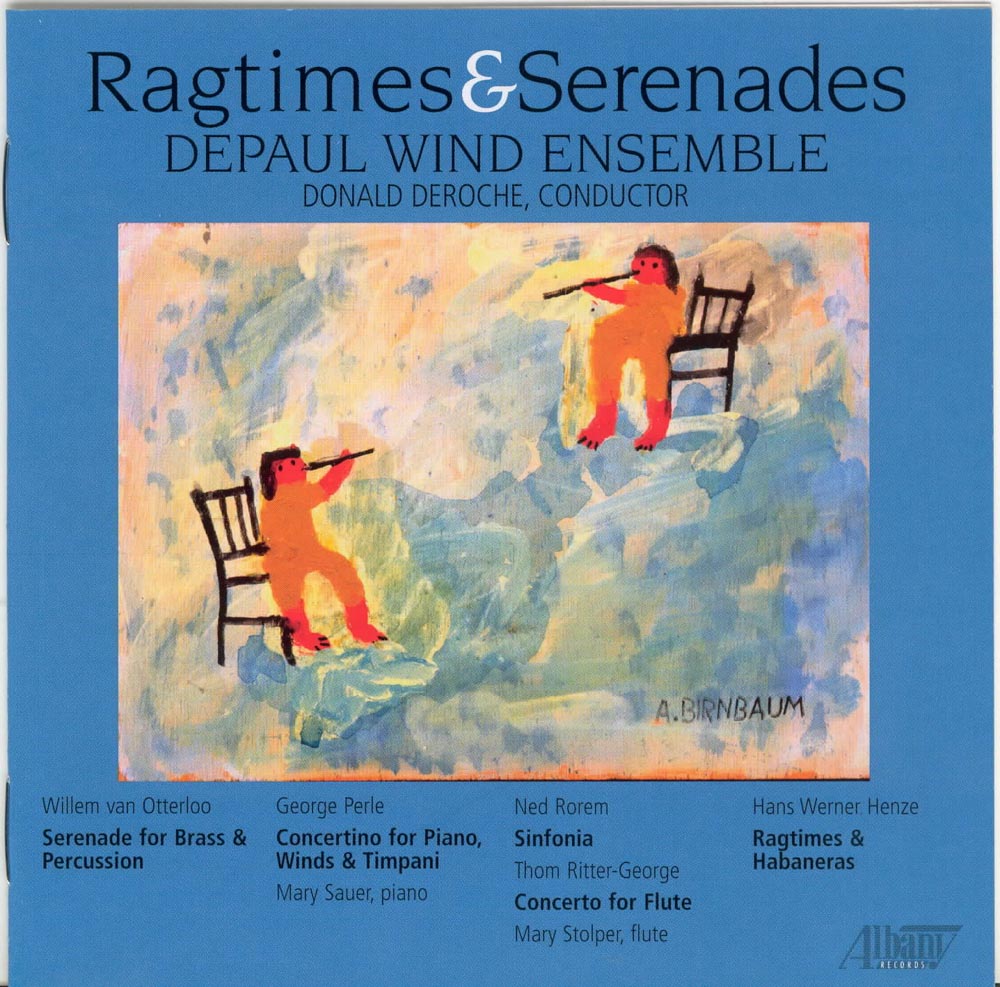Ragtimes & Serenades
Mary Sauer (piano), Mary Stolper (flute), DePaul Wind Ensemble, Donald DeRoche (conductor)
The Dutch composer, Willem van Otterloo, composed his Serenade in 1944. It is in a post romantic style and runs the gamut from charming to brilliant to reflective. It is loosely based on the wind serenades of the 18th and 19th centuries and consists of four movements - March, Nocturne, Scherzo and Hymn. As the titles suggest, this music is meant to be accessible to the listener and appropriate for concert as well as occasional performances. George Perle has been celebrated as both a composer and theorist of extraordinary accomplishments. He is a favorite son of the DePaul School of Music, where he earned his BA in 1938. The Concertino for Piano, Winds and Timpani was composed between September 24, 1978 and February 20, 1979, on a commission from the Fromm Music Foundation. It was premiered in Chicago in April 1979 with Ralph Shapey conducting. Ned Rorem's Sinfonia was written as the first commission for the American Wind Symphony Orchestra and its conductor, Robert Boudreau. It is cast in four brief sections, two of which are lyrical and reflective, and two of which are full of energy. The work is short, but possesses both wit and charm. Thom Ritter-George grew up in Detroit, Michigan. Today he is a Professor of Music in Idaho State University's Department of Music. His Concerto for Flute was written in early 1966 on commission from the music publisher, P. Litchard Toland. Mr. Toland requested two special features for the new work. The first was that the solo part should be written with optional scoring for piccolo in certain passages. The second was that there should be three versions of the accompaniment - orchestra, piano and wind ensemble. In his role as Orchestra Librarian for the Eastman School of Music, Mr. Toland had seen many situations where accompaniment alternatives were needed. Hans Werner Henze's Ragtimes and Habaneras was originally written for brass band and was re-scored for wind orchestra by his pupil Marcel Wengler. The work consists of eleven short dance movements reminiscent of ragtime dances like the Charleston and the Foxtrot, and Latin American dances such as the tango, Son and Rumba. The final movement is a kind of cross between a ragtime and a march. While the harmonic materials are modern and each form a kind of short parody, the music is full of humor and fun.
Track Listing
| Title | Composer | Performer |
|---|---|---|
| Serenade for Brass and Percussion | Willem van Otterloo | DePaul Wind Ensemble, Donald Deroche, conductor |
| Concertino for Piano, Winds and Timpani | George Perle | DePaul Wind Ensemble, Donald Deroche, conductor, Mary Sauer, piano |
| Sinfonia | Ned Rorem | DePaul Wind Ensemble, Donald Deroche, conductor |
| Concerto for Flute and Winds | Thom Ritter-George | DePaul Wind Ensemble, Donald Deroche, conductor, Mary Stolper, flute |
| Ragtimes & Habaneras | Hans Werner Henze | DePaul Wind Ensemble, Donald Deroche, conductor |
Reviews
- “
"...an absolutely terrific disc that lovers of symphonic wind ensemble music will immediately want to add to their collections."
*Album cover provided for Editorial use only. ©Albany Records. The Albany Imprint is a registered trademark of PARMA Recordings LLC. The views and opinions expressed in this media are those of the artist and do not necessarily represent or reflect the views and opinions held by PARMA Recordings LLC and its label imprints, subsidiaries, and affiliates.

